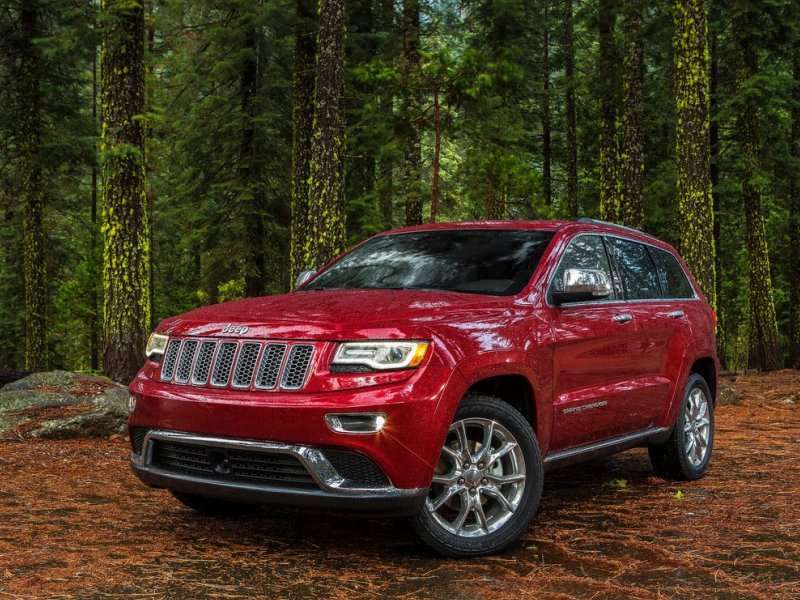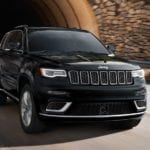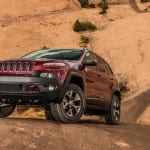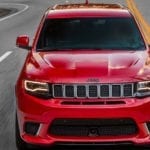The Jeep Grand Cherokee was first introduced to the mass consumer market in 1993, but the origins of the rugged SUV actually go back further, to 1983. Back then, the American Motors Corporation owned Jeep, and the company was working to create a successor to the hugely popular Jeep Cherokee. The larger version of the hit SUV caught the attention of Chrysler, who purchased the American Motors Corporation in 1987. The very first Jeep Grand Cherokee was actually the first Jeep vehicle to be manufactured under the Chrysler name.
Officially debuting at the North American International Auto Show in 1992, the Grand Cherokee was an instant hit and has been one of the most popular SUVs on the market, ever since. The Grand Cherokee offers drivers the rugged aspect of Jeep, and the luxury Chrysler feel. The popularity of the nameplate has not waned, which is one of the reasons that used Jeep Grand Cherokee models, are still being sold across the country.
The current Jeep Grand Cherokee represents the SUVs fourth generation. The most popular SUV in America is so in-tune with what midsize SUV drivers are looking for, that the iconic vehicle has not had to change drastically over the years. The Jeep Grand Cherokee has been a show stopper since it was first introduced to the market and is still setting itself apart from other vehicles in its segment.
What Makes the Grand Cherokee Different?
Aside from their rugged good looks, luxurious amenities, and the undeniable appeal of the “Jeep Culture,” what is it that draws drivers to the Grand Cherokee? This mid-size SUV may not appear much different from others in its class, but the entire way the Grand Cherokee is built makes it stand out from all midsize SUVs on the road today.
Unibody Chassis vs. Body-On-Frame Construction
The Jeep Grand Cherokee was immediately distinguished from the rest of its class, by being the first midsize SUV to offer a unibody chassis. The unibody chassis is one that combines the body and frame of a vehicle into one single structure. The result of this powerful unitary structure is that it is stronger, weighs less, allows for more interior space, and is safer in the event of a collision.
While the Jeep Grand Cherokee has always been built on this type of chassis, its competition was still using the heavier, body-on-frame construction. This type of construction builds the frame and body separately and then fuses them together. The result? A heavier, less efficient, and more rigid ride, that results in more serious injuries and deaths when a collision occurs.
Today, most midsize SUVs have adopted the unibody construction model, but because they did not always use this safer chassis method, used versions can be less efficient, less safe, and uncomfortable to ride in.
Jeep has always built the Grand Cherokee on the safer, more efficient unibody chassis. This is just one of the reasons that the used Jeep Grand Cherokee midsize SUV, is one of the best on the market. Whether you are looking at an original 1993 model or a used 2013 model, you can rest assured knowing that your Grand Cherokee features a unibody chassis, and will keep you safe on all of your adventures.
Built to Take You On and Off the Road
The body construction of the Grand Cherokee is not the only thing that makes it stand apart from other midsize SUVs. A major draw for drivers to head over to the Jeep brand is that every Jeep vehicle is equipped to take you wherever you want to go – whether there is a road to get you there or not.
Every used Jeep Grand Cherokee is equipped for adventure. These fully capable SUVs aren’t just rugged looking, they are rugged doing. The Grand Cherokee is specifically designed to handle multiple terrains, weather conditions, and even the steepest slope. Other midsize SUVs may claim to be off-road capable, but there is absolutely no comparing to the off-road performance capability of a Jeep Grand Cherokee.
The Most Awarded SUV – EVER
The Jeep Grand Cherokee has earned more awards and accolades in its lifetime, than any other SUV on the road. Again and again, the Grand Cherokee takes home more awards than all of its competitors. The award winning SUV has been collecting these honorable recognitions and awards since it was first introduced, which means that even when you purchase a used Jeep Grand Cherokee, you know you are getting a quality, reliable, and award-winning vehicle.
Year after impressive year, the Jeep Grand Cherokee stacks up the most impressive awards in the industry. Check out a list of just some of the awards that the Jeep Grand Cherokee takes home each year:
- Green SUV of the Year
- Most Popular Midsize Traditional SUV
- SUV of Texas
- Official Winter Vehicle of New England
- Ward’s 10 Best Engines
- Insurance Institute for Highway Safety Top Safety Pick
- Mid-SIze SUV Challenge Winner from Cars.com
- Best Premium Standard Utility
- Consumers Digest Best Buy
- Five Star Side Crash Rated
- Best in Class 4×4 Capability
- Best in Class Ground Clearance
- Best in Class Driving Range (V6 & V8)
These awards are just one of the many ways that the Jeep Grand Cherokee sets itself apart from the competition, and why drivers who are looking for a used midsize SUV, ultimately end up purchasing a used Jeep Grand Cherokee.
Weighing in with the Competition
Ever since the midsize crossover segment has gained in popularity, there has been an increase in segment options. These newer midsize SUVs are direct competitors of the Grand Cherokee, but none of them can stand up to the most awarded SUV in America. From the Ford Escape, Honda CR-V, and the Kia Sorento – the Grand Cherokee always comes out on top.
The 2014 Grand Cherokee offers drivers an impressive combined fuel economy of 24 miles per gallon, while the 2014 Sorento tops out at a combined fuel rating of only 21 MPG. The same model year of the Grand Cherokee offers a sporty nine-speed automatic transmission, while the Sorento only offers a six-speed transmission.
The 2014 CR-V also has a hard time keeping up with the 2014 Grand Cherokee. The CR-V offers nearly 3 cubic feet LESS passenger room than the Jeep Grand Cherokee, and the CR-V also comes up 500 pounds short for total towing capacity.
Finally, the 2014 Jeep Grand Cherokee is also showing up the 2014 Ford Escape in some important areas. The Cherokee offers a 2.4-liter engine, while the Escape only manages 1.6-liters. The 2014 Grand Cherokee comes equipped with power four-way lumbar support for the driver, and daytime running lights. The Escape includes lumbar support, but only two-way, and the bowtie SUV does not come with daytime running lights.
These are just a few examples of one model year of the Grand Cherokee. Nearly all Grand Cherokee models outweigh the competition in major ways, regardless of the model year. If you want a used SUV that will provide a quality, reliable, and safe ride for years to come – a used Jeep Grand Cherokee is the only name you need to remember!
A lot can change in five years. So when we found ourselves taking a look at this article, we thought to ourselves, “Why not bring the story of the 4th-gen used Jeep Grand Cherokee up-to-date?” Even more so, reading it made us conscious to the fact that – aside from extolling its overall virtues, with a focus on the then-current 2014 model – we hadn’t even begun to touch upon its origins and timeline. Hindsight being 20/20, let’s take a trip back almost four decades to the early 1980’s. A time when a vehicle known as the XJC would serve as a game-changer, revolutionizing Jeep’s design and production methods.
Now under the executive rule of Chrysler, Jeep was interested in creating and upsized version of the newly popular Jeep Cherokee (XJ). While originally slated for a late-80’s release the planned successor (coded as the XJC) would find itself pushed aside by Chrysler in favor of redesigns of the then-popular minivan. This deferment of prioritization would push the arrival date of the XJC to 1993, recoded as the ZJ and given the all-too-appropriate name of the Jeep Grand Cherokee.
First Generation (1993-1998)
The first-gen run of the Grand Cherokee would last six model years, marked by a handful of evolutionary changes one might expect from a new offering. Originally it was served up with a single powertrain, in the form of a 4.0-liter straight six paired with either the standard five-speed manual transmission or a four-speed automatic. Serving up 190 horsepower, the ’93 Grand Cherokee was a confident performer – served up in three distinct trim levels: the (base) SE, Laredo and Limited.
By the mid-90’s engine configurations would expand to include a 5.2-liter V8, a 5.9-liter variant and a 2.5-liter TurboDiesel. Depending on the configuration, hp ratings would reach as high as 245 hp, with 345 lb-ft of torque (with the 5.9, introduced in 1997). The engineering would also be modified to adhere to the progressively more stringent EPA regulations. By this time, the manual transmission had been dropped altogether and the Grand Cherokee was largely celebrated as a true luxury-inspired offering, achieving the original intent of Jeep to offer a truly upmarket 4×4.
Second Generation (1999-2004)
With most of the initial reconnaissance providing the direction as to where the Grand Cherokee should go next, the second-gen update (coded WJ) seemed focused on refinement. Presenting a fairly significant overhaul, it shared only 127 parts with its predecessors (predominantly fasteners, according to records). With a stronger, reinforced unibody frame the updated Grand Cherokee would offer enhanced safety and a significant reduction in noise vibrations.
Among the changes under the hood was the upgrade of the ZJ’s pushrod V8 options to Chrysler’s (then) new PowerTech V8, along with an upgrade to the straight-six with a redesigned intake manifold. And some were paired with (what was being called) a “four-speed automatic” transmission, the use of planetary gear sets actually created six speeds (up and downshift combined) making it, arguably, the first mass-produced six-speed automatic transmission.
Another notable upgrade was the introduction of Quadra-Drive, a new two-speed three-mode transfer case which combined with progressive locking differentials in each axle allowed for automatic traction control between all four wheels.
Third Generation (2005-2010)
The third-gen Grand Cherokee (now coded as the WK) continued the forward motion with a number of upgrades that helped to reclassify it as a “truck-based SUV” offering “crossover refinement and capability”.
Such refinements included an updated suspension, including leading-arms front suspension with an independent double-wishbone, offering even more tempered handling. It also includes a number of updated powertrain configurations to be introduced over the life of the generation.
Right off the bat, a new 3.7-liter V6 (rated for 215 hp and 235 lb-ft) of torque replaced the 4.0-liter straight-six. It would be offered alongside a 4.7-liter V8 (which would be upgraded in 2008, rated for up to 305hp and 334 lb-ft) a 5.7-liter Hemi V8 (to be upgraded for up to 357hp and 389 lb-ft) a 6.1-liter Hemi V8 (420hp and 420 lb-ft) and a Mercedes-Benz sourced 3.0-liter V6 (delivering 215hp and 376 lb-ft). Which brings us to the relatively current (if you consider a near-decade-old generation to be ‘current’) engine configurations.
Fourth-Generation (2011-present)
From its conceptualization, the fourth-gen WK2 was intended to serve as a depiction of Chrysler (now FCA’s) forward-thinking mentality, and overall viability within the changing landscape of post-depression automakers. Combining all the classic notes of design and engineering that had become intrinsic to the Grand Cherokee image, but now combined it with a wealth of performance options and an evolving slate of tech-centric amenities which would soon become the standard expectation of most every driver.
As noted in our previous entry, the Grand Cherokee would have asserted itself as a highly-awarded mainstay of the SUV segment by this point, more specifically the ‘Most Awarded SUV’ ever. The accolades would cover nearly every area imaginable, from safety and luxury, to value and off-road capability, validating every step of the vehicle’s continued evolution.
By this point, the Quadra-Drive four-wheel drive system would have expanded to include three different variations, now featuring terrain-specific settings (such as snow, sand, rock). In addition the option of Quadra-Lift, adjustable air suspension would allow an increase of the vehicles’ clearance to 11.1-inches, keeping the aspirational vehicle true to its SUV roots. And yet, a number of features would continue to make the Grand Cherokee an enticing, and compelling offering distinguished by its uniqueness.
Most notable to many would be FCA’s organic decision to bridge the WK2’s iconic image to a new generation of high-performance vehicles that the automaker was redefining itself by. To date, this has been best embodied by two particular models…
Grand Cherokee SRT8
FCA’s Street & Racing Technology division might be best known for creating hi-po’d performance offerings like the Viper and Prowler, as well as the Charger and Challenger, but FCA’s decision to give the same treatment to the Grand Cherokee spawned the SRT8, first introduced in 2011.
Powered by a 6.4-liter naturally aspirated HEMI V8 engine, the SRT8 served up 470 hp and a matching 470 lb-ft of torque, while offering improved fuel efficiency. Factor in a 4.6-second sprint to 60mph and a 13.3-second quarter mile and it’s easy to see the appeal.
Grand Cherokee SRT Trackhawk
And then, there’s the Trackhawk, first introduced for the 2018 model year. Powered by a 6.2-liter Hellcat HEMI V8, the Trackhawk wrangles a quaking 707hp and 645 lb-ft of torque, as well as a capable 7,200 lb towing capacity. A seemingly limitless list of features and optional upgrades make the Trackhawk a near-perfect amalgamation of FCA’s strengths. Offering power, performance, iconic styling, luxury, technology and 4×4 versatility there are very few boxes that it fails to tick with confidence.
Why Used Jeep Grand Cherokee SUVs are Outselling the Competition
That was the original title of this article when written back in 2015, and it becomes easy to see that nothing has really changed. If anything, this walk down memory line asserts the Jeep Grand Cherokee as one of the most ambitious and continually evolving SUV offerings out there. It becomes easy to see what pre-owned GC’s manage to captivate so many buyers, regardless of the year, model or trim level that they choose.









